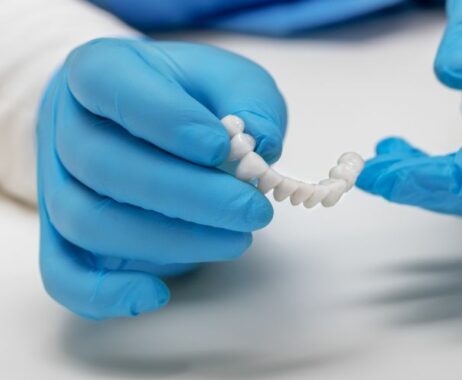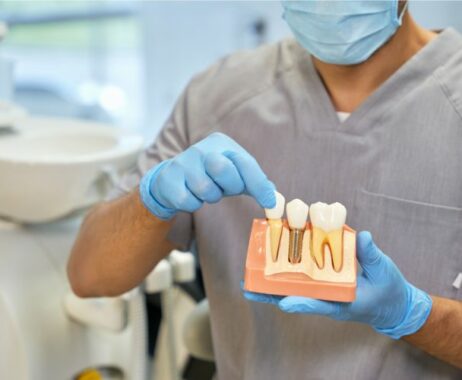Missing teeth, whether due to tooth decay or injury, can be uncomfortable and greatly affect your self-esteem. Those missing teeth may mean you don’t smile as much as you could be, or that chewing is placing greater pressure on your remaining teeth. It can even affect how you speak and the shape of your face. However, dental bridges are an affordable, painless replacement method that will restore oral health and return your natural-looking smile.
Restoring Your Smile with Dental Bridges
A dental bridge is a permanent and natural-looking solution to bridge the gap between healthy teeth when one or more teeth are missing. This restoration process not only improves the aesthetics of your smile, but it also restores optimal oral function and will have you speaking and chewing like normal again. Not only that, but a dental bridge will also help to prevent your teeth from moving and causing unsightly gaps between your other teeth.
The Different Types of Dental Bridges:
- Traditional dental bridge. This is where your dentist places dental crowns on the abutment teeth (the healthy teeth on either side of the gap) and the artificial teeth, called the pontic, fill the gap.
- Cantilever bridges. A cantilever bridge is used when healthy, natural teeth are only on one side of the gap.
- Maryland dental bridge. This type of dental bridge is typically used on front teeth. It’s where metal wings are used to secure the bridge instead of crowns.
- Implant-supported bridge. If you have three or more missing teeth, your bridge may be supported by a dental implant instead of natural teeth.
Are You a Candidate for a Dental Bridge?
When considering if you are a good candidate for a dental bridge, your dentist will consider several factors. This includes:
- If you are missing one or more teeth and the size of the gap.
- Your oral hygiene habits. You need to maintain good oral hygiene to keep your teeth and gums healthy so they can continue to support the dental bridge.
- Your age. Dental bridges are not typically used on children and your bone density must be able to support the bridge.
- The condition of the teeth on either side of the gap and whether they are natural.


The Dental Bridge Procedure
A dental bridge is essentially a prosthetic fixed into the space left by missing teeth. Having a dental bridge is a painless procedure, but it sometimes requires more than one appointment to fit the bridge.
First, the dentist will thoroughly examine your teeth and gums to look for signs of tooth decay or gum disease as these will need to be treated before you have crowns placed to support the dental bridge. Then you may need to have X-rays taken and measurements taken for the bridge. You will be given a local anaesthetic to numb your mouth before any further treatment.
Next, the abutment teeth (those on either side of the gap) are shaped so that the dental bridge can be secured. Dental impressions are taken so that a mould can be made for your bridge, and you may be given a temporary bridge while you wait for it to be made to your specific needs.
The second part of the procedure involves fitting the dental bridge. It is bonded in place using dental cement and while you may experience minor swelling, over-the-counter pain relief will keep you feeling comfortable.
Caring for Your Dental Bridge
After your dental bridge is fitted, you will need to take a few steps to maintain it. Brush your teeth and the implant twice a day using a soft circular motion to avoid damage. Avoid hard, crunchy, sticky, and sugary foods. The dentist will advise you if you need to use a special type of dental floss or take extra care around the implant. Lastly, regular dental check-ups will help extend the lifespan of your dental bridge.
Dental Bridge FAQs
A: A dental bridge is a fixed prosthetic solution used to replace one or more missing teeth. It consists of crowns for the teeth on either side of the gap (anchor teeth called abutments) and false teeth in between, known as pontics, restoring both function and that seamless smile.
A: Dental bridges effectively fill gaps from missing teeth, anchored by surrounding natural teeth or implants. Made from materials like porcelain fused with metal or ceramics, they restore chewing function and improve the appearance of your mouth. Bridges can last over a decade with proper care and are the perfect solution for any patient seeking a natural-looking smile.
A: Dental bridges not only fill the void of missing teeth but also restore your ability to bite and chew comfortably. They prevent adjacent teeth from drifting, maintain the shape of your face, and offer a natural look and feel. A bridge can boost your confidence, resulting in a radiant smile for years to come.
A: The cost of dental bridges in NSW varies based on materials and the level of complexity, but they’re a cost-effective, long-term solution. Most dental clinics in Sydney offer the procedure for roughly $4500. Investing in a bridge ensures restored function and appearance, and with proper care, it’s a one-time expense that will serve you and your smile for years.
A: A dental bridge, with diligent care and regular check-ups, typically lasts between 10–15 years. Its longevity can even extend further when accompanied by good oral hygiene practices. Investing time in its maintenance will ensure you benefit for years, thanks to the dental bridge’s function and beautiful form.
A: During a dental bridge procedure, the abutment teeth are first prepared to accommodate crowns. Impressions are then taken to design a custom bridge. Once crafted, the bridge is checked for fit and bite alignment. After any necessary adjustments, it’s cemented in place, restoring the gap seamlessly.
A: Alternatives to dental bridges include dental implants, which are surgically fixed to the jawbone and topped with a crown. Partial dentures, which are removable, can also replace missing teeth. A combination of implants and bridges can also be considered in certain situations. The best choice depends on your individual dental needs and preferences, so be sure to discuss the details with your dentist in a consultation and ask as many questions as you need.
Your Qualified Dental Bridge Expert
Searching for top-quality dental care in the North Sydney area? At KB Village Dental, our patients are our top priority. Whether facing dental trauma, gum diseases, or the need for cosmetic surgery, our services cater to diverse dental needs. From sleep apnoea and Invisalign to root canal therapy and teeth whitening, we handle it all.
Conveniently located for residents of McMahons Point, Kirribilli, Mosman, Neutral Bay, Crows Nest, and the wider lower North Shore, our state-of-the-art equipment ensures nothing but exceptional results.
Wondering about our range of treatments? Explore our extensive service list. Don’t miss the chance to tour our practice with Dr Evan Soulos, an emergency dentist with a stellar reputation for 5-star dental practices and a team of professionals behind him.
To book an appointment or for any other enquiries, drop us a message.
Request an Appointment
Call (02) 9964 9166 or request an appointment online.
Our convenient Kirribilli location, nestled between Milsons Point and Neutral Bay, makes us your local Sydney North Shore dentist. If you’re travelling by car, there’s plenty of street parking nearby. And we’re only a short walk from Milsons Point train station.
Visit the North Shore smile experts and give your teeth a treat.
